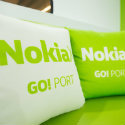Nokia Opens Its Optical Box of Tricks
Having kept its powder dry during Alcatel-Lucent's final 12 months, the optical team at Nokia has unveiled a host of developments including potentially game-changing 200G long-haul capabilities.
March 18, 2016

Having kept its powder dry during the past year or so, the optical transport team at Nokia today unveiled a host of developments that should make for some interesting talking points at next week's OFC event (the annual gathering place for the optical networking community) in Anaheim, Calif.
The team in question was formerly the optical division at Alcatel-Lucent, which persevered with its product development processes in the run-up to the recent acquisition by Nokia Corp. (NYSE: NOK) but didn't announce anything significant during that self-imposed "quiet period."
As a result, there's plenty to talk about: The team has been busy enhancing its portfolio to meet the widespread demand for 100Gbit/s service capabilities and meeting the increasing demand for 200Gbit/s capabilities. The full details can be found in the press release issued Wednesday -- see Nokia Unveils PSE-2 Chip, Expands 1830 PSS Product Family -- but here are the highlights:
The unveiling of the Bell Labs-developed Photonic Service Engine version 2 (PSE-2) 500Gbit/s programmable chipset, the "first truly programmable electro-optics engine," according to Sam Bucci, head of optical networking at Nokia. Bucci says the new digital signal processor (DSP) delivers a "number of industry firsts," including single carrier 400 Gbit/s, long-haul 200 Gbit/s (up to 2,000 kilometers) and ultra-long-haul 100 Gbit/s (up to 5,000 kilometers). The chipset, which comes in two designs -- the PSE-2s "super coherent" for the top end capacity and long reach and the PSE-2c "compact" optimized for 100Gbit/s DWDM applications -- boasts at least 50% less power consumption per bit compared with the original PSE chip that was launched in 2012. (See AlcaLu Can Do 400G Too.)
The launch of the 1830 PSS-24x packet/OTN switch, built using the PSE-2s and Nokia's Transport Switching Engine silicon. This latest member of the Photonic Service Switch (PSS) family offers 9.6 Tbit/s of switching capacity in a half-rack shelf and up to 48 Tbit/s for a full rack. It is compatible with the existing 1830 PSS, which is currently used by more than 600 operators, according to Nokia. Bucci and his team insist the PSS-24x uses 50% less power and takes up 50% less space than the existing 1830 and other "comparable solutions," but declined to elaborate on any comparisons with rival systems, saying only that they believe it is "ahead of the market." The PSS-24x will be available in June or July.
Available now is the 1830 PSS 500Gbit/s DWDM Muxponder, a line card housing the PSE-2s that slots into existing 1830 PSS systems, offering five 100Gbit/s client side ports. Nokia says this is already shipping to 25 (unidentified) customers.
The doubling of capacity in DWDM systems to 192 channels by using the L-band (long wavelength band) as well as the C-band (conventional wavelength band). Nokia says it can do this by integrating PSE-2 interfaces with colorless-directionless-contentionless (CDC) and Flexgrid technology to offer the "industry's first C+L band CDC-F system."
"These are the first big optical announcements under the Nokia ownership," says Manish Gulyani, VP of marketing for IP/Optical Networks at Nokia, who believes the single carrier 400Gbit/s application will be "good for data center interconnect" as it offers a lot of capacity "on just one frequency slot" at distances of up to 150 kilometers.
He's also pumped about the 200Gbit/s offering, which at 2,000 kilometers reach covers long-haul as well as metro applications.
What the Nokia team isn't offering up is any detail on the pricing of the new technologies. "The economics are better," is as far as Bucci will go.
Want to know more about 100G? Check out our dedicated 100G content channel here on Light Reading.
All in all, then, that's quite the package -- but is it worth shouting about? It seems so.
"Nokia is increasing line card density for its OTN switching and transport platform with a new coherent DSP and OTN switching chip," notes Andrew Schmitt, lead analyst at Cignal AI. "The new DSP allows a customer to have a single line card work for just about every reach and makes 200Gbit/s more deployable," he adds.
The 200Gbit/s development also stood out for Heavy Reading senior analyst Sterling Perrin. "They surprised me that there was so much to talk about and it shows they are incredibly committed to the optical sector," says Perrin. "What's interesting is that they have the chip and the system product at the same time. For me, the 200Gbit/s long-haul application is the most interesting and most unique, although the use of the L-band as a way to boost capacity is also interesting, as long as it's economical. If it is viable then operators could use the L-band capacity to meet their needs instead of having to drive channel rates higher."
But it's the 200Gbit/s development that has really caught Perrin's eye. He says 200Gbit/s metro systems have proven very popular, especially for data center interconnect, but demand for such systems has been in the metro only. "It's a technology that has been limited by its reach," says the analyst.
But "enabling single carrier 200Gbit/s over 2,000 kilometers will create a rethink of the long-haul options -- no-one else has anything that is shipping that is the same as this -- but it will all depend on cost. It has to be economical… if it is cheaper than 2x100Gbit/s then for sure there will be demand."
But any success with a single carrier long-haul 200Gbit/s system will, in Perrin's view, "push out demand for single carrier 400 Gbit/s even further."
So it looks like 200 Gbit/s will be a major talking point at OFC, where it looks like the annual battle between the major optical systems vendors -- including Ciena, Cisco, Coriant, Huawei, Infinera and Nokia -- will be as intense as ever. Ciena has also made a pre-OFC system announcement and it'll be a surprise if there aren't more to come. (See Ciena Unveils 6500 T-Series Packet-Optical Platform.)
— Ray Le Maistre,


 , Editor-in-Chief, Light Reading
, Editor-in-Chief, Light Reading
Read more about:
EuropeYou May Also Like









